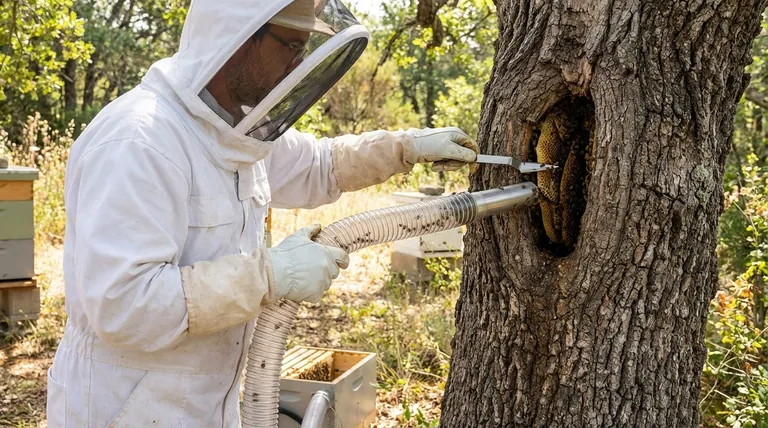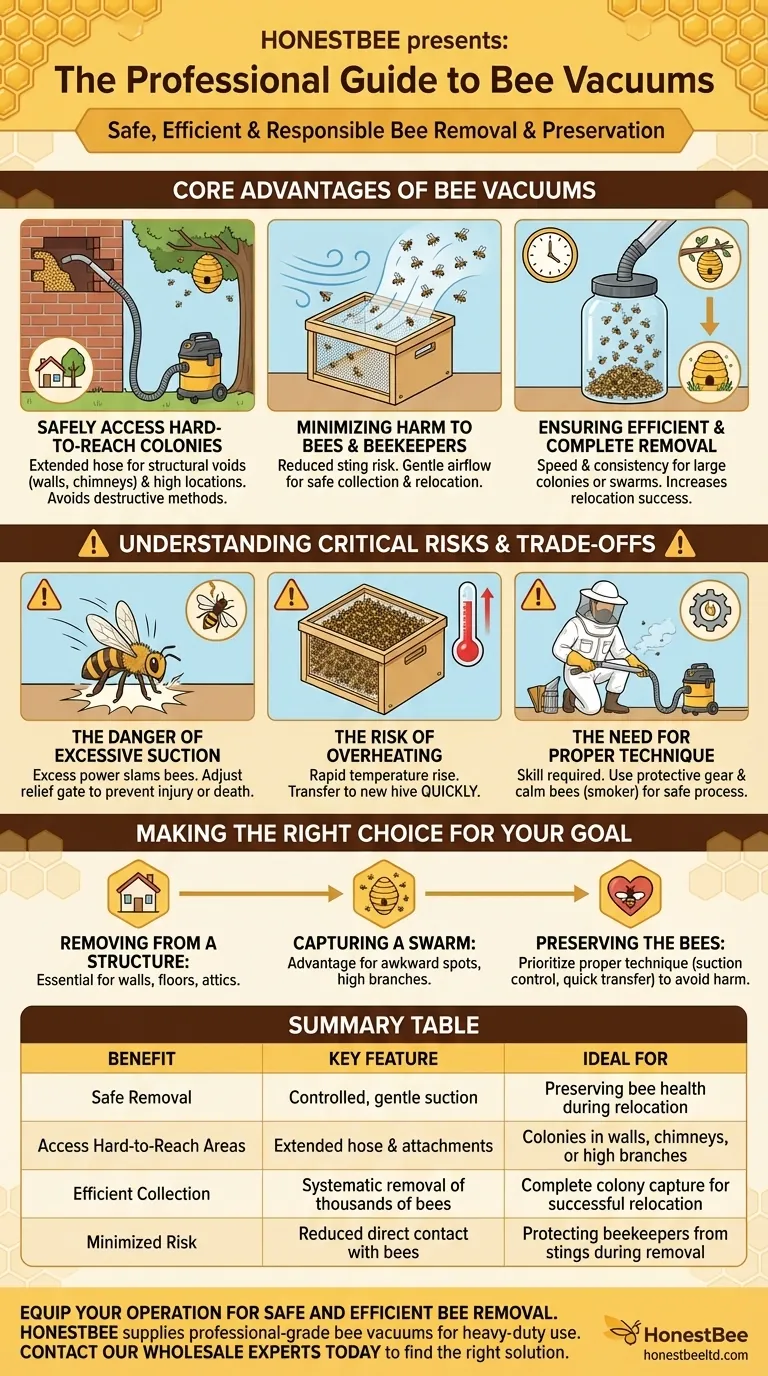In short, a bee vacuum offers a controlled and efficient method for removing honey bees, especially from difficult locations. It is designed not to harm the bees, but to gently collect them so they can be safely relocated to a proper hive.
A bee vacuum is fundamentally a tool for preservation. Its primary benefit is the ability to safely collect a colony with minimal stress to the bees and minimal risk to the beekeeper, but its effectiveness is entirely dependent on proper technique.

The Core Advantages of Bee Vacuums
A bee vacuum is far more than a modified shop-vac. It's a specialized piece of equipment designed with the bees' welfare in mind, offering distinct advantages over other removal methods.
Safely Accessing Hard-to-Reach Colonies
The most significant benefit is the ability to reach bees where other methods fail. A vacuum hose can be extended into areas that are otherwise inaccessible.
This includes structural voids like wall cavities and chimneys, as well as natural locations like high tree branches. Without a vacuum, these removals can be destructive, dangerous, or impossible.
Minimizing Harm to Bees and Beekeepers
A well-designed bee vacuum allows for the removal of a colony with minimal direct contact. This drastically reduces the risk of stings for the operator.
More importantly, it is designed for the bees' safety. By controlling airflow, it gently lifts the bees from the comb and deposits them into a ventilated collection box, keeping the colony together for relocation.
Ensuring an Efficient and Complete Removal
When dealing with an established colony or a large swarm, a bee vacuum provides speed and consistency.
It allows an operator to collect thousands of bees in a systematic and predictable manner. This ensures that the vast majority of the colony is captured, increasing the chances of the relocated hive thriving.
Understanding the Critical Risks and Trade-offs
While powerful, a bee vacuum is not a simple appliance. Improper use can easily harm or kill the very bees you are trying to save. Understanding the risks is key to using it successfully.
The Danger of Excessive Suction
The most common mistake is using too much power. Excessive suction can slam bees against the inside of the hose or collection box, causing injury or death.
Most bee vacuums have an adjustable relief gate for this exact reason. You must test the suction and ensure it is just strong enough to lift the bees without causing trauma.
The Risk of Overheating
Once collected, the bees are packed densely inside the collection box. Their combined body heat can cause the temperature to rise rapidly, especially on a warm day.
It is critical to transfer the bees into their new hive quickly after collection. Leaving them in the vacuum box for too long can lead to overheating and significant losses.
The Need for Proper Technique
Using a bee vacuum effectively is a skill. The operator must know how to calm the colony before starting and how to manage the equipment properly.
Always wear full protective gear, and consider using a smoker to pacify the bees beforehand. This makes the collection process calmer and safer for everyone involved.
Making the Right Choice for Your Goal
Before using a bee vacuum, clearly define your objective. Your goal will determine if it's the right tool and how you should approach the task.
- If your primary focus is removing a colony from a structure: A bee vacuum is an essential tool for safely and completely clearing bees from walls, floors, or attics.
- If your primary focus is capturing a swarm in an awkward spot: The vacuum gives you a significant advantage for swarms on high branches or other locations where a simple shake-and-catch is not feasible.
- If your primary focus is preserving the bees: You must prioritize learning the proper technique, including suction control and quick transference, to avoid harming the colony.
Used correctly, a bee vacuum is a powerful instrument for the responsible preservation and management of honey bees.
Summary Table:
| Benefit | Key Feature | Ideal For |
|---|---|---|
| Safe Removal | Controlled, gentle suction | Preserving bee health during relocation |
| Access Hard-to-Reach Areas | Extended hose and attachments | Colonies in walls, chimneys, or high branches |
| Efficient Collection | Systematic removal of thousands of bees | Complete colony capture for successful relocation |
| Minimized Risk | Reduced direct contact with bees | Protecting beekeepers from stings during removal |
Equip your operation for safe and efficient bee removal. A bee vacuum is an essential tool for commercial apiaries and beekeeping equipment distributors focused on responsible colony management. HONESTBEE supplies professional-grade beekeeping equipment, including reliable bee vacuums designed for heavy-duty use. Enhance your services and protect your valuable bees—contact our wholesale experts today to find the right solution for your needs.
Visual Guide

Related Products
- HONESTBEE Professional Long Handled Hive Tool with Precision Cutting Blade
- Plastic Handle Single Row Artificial Fiber Bee Brush
- Professional Dual-End Stainless Steel Hive Tool for Beekeeping
- HONESTBEE Advanced Ergonomic Stainless Steel Hive Tool for Beekeeping
- Wholesales Dadant Size Wooden Bee Hives for Beekeeping
People Also Ask
- What tools are used for cleaning frames? A Beekeeper's Simple 4-Tool Guide
- What is the hive tool used for? The Essential Multi-Tool for Every Beekeeper
- How should beekeepers handle bees when using a hive tool? Master Calm, Deliberate Techniques
- Why do hive tools have a hole? Unlock the Secret to Efficient Beekeeping
- What is a hive tool used for in beekeeping? Your Essential Guide to Hive Management



















